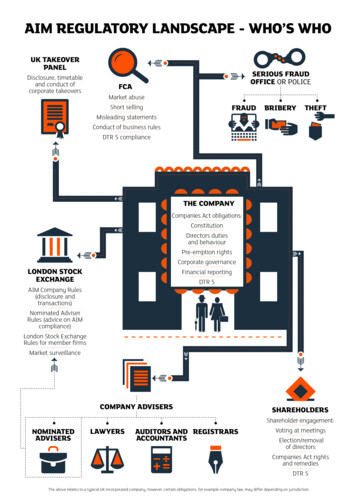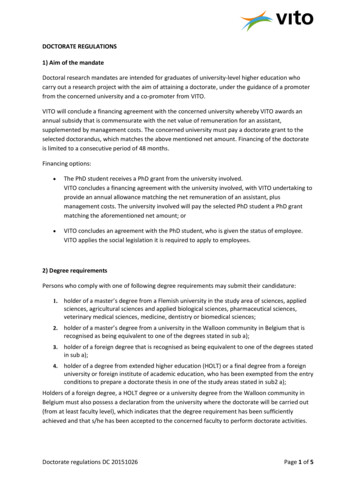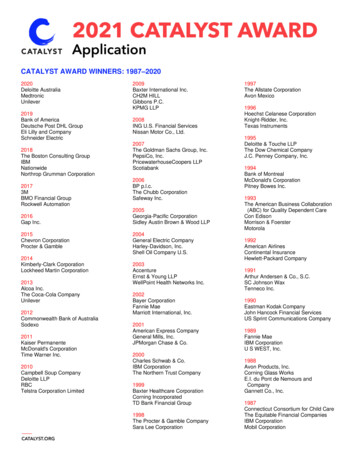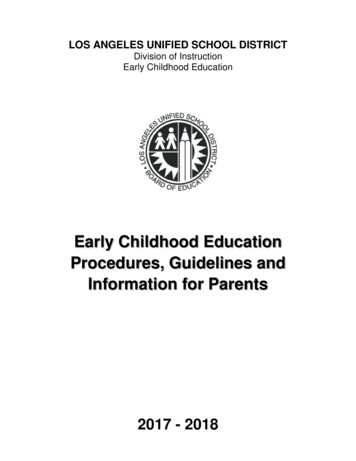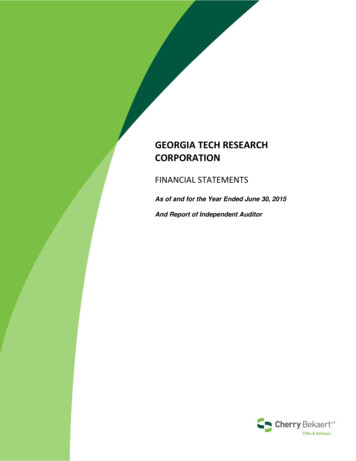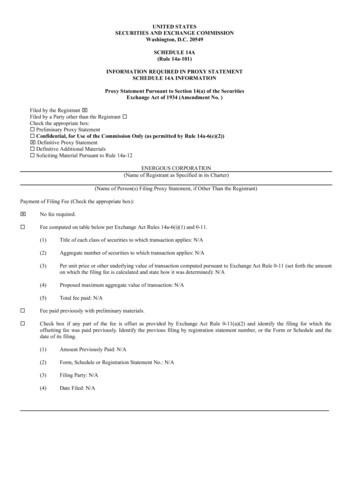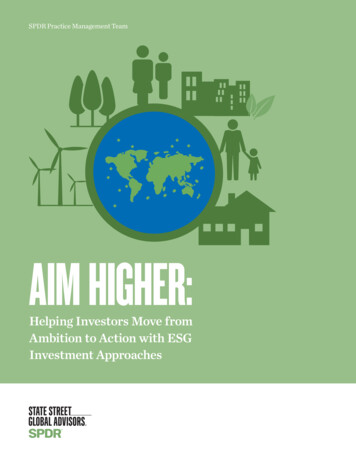
Transcription
SPDR Practice Management TeamAIM HIGHER:Helping Investors Move fromAmbition to Action with ESGInvestment Approaches
Aim Higher: Helping Investors Move From Ambition to Action With ESG Investment ApproachesCAN ESG INVESTMENTSLEAD TO MORESUSTAINABLE PERFORMANCE?If ESG factors can improve long-term performance, how can we help clients incorporatesustainability into their investments? And if we believe that sustainability practices can add value,are the investment standards of today fit for client goals over the long term?Traditional metrics such as sales growth, market share and valuation are not enough. There is agrowing need to address sustainability factors, alongside conventional securities analysis.A more comprehensive approach to investing includes material, non-traditional issues:environmental, social and governance (ESG) factors.WHAT’S IN A NAME?Helping investors identify the right ESG strategy for their goalsThe term “ESG” covers several related but distinct concepts, including:Sociallyresponsibleinvesting,or SRI1920sResponsibleinvesting,or RI1930sSustainableinvesting1990sSource: State Street Global Advisors, “Performing for The Future. ESG’s Place in Investment Portfolios. Today and Tomorrow,” 2017 ESG Survey Report.The rapid evolution over the past 20 years has resulted in a mix of terminology across the industry.Phrases such as “impact investing” and “ESG integration” have become widespread, but whatthey actually mean isn’t always clear.1 Lack of clarity can create confusion and impede progress.Establishing a standard language to discuss ESG goals and strategies can help advisors communicateclearly with clients. It helps clients understand the features and benefits of ESG investing. Having aclear and straightforward framework for understanding and comparing options is the first step inguiding clients on ESG investing.
UNDERSTANDING ESG TERMINOLOGYESG IntegrationIncorporates ESG data, alongside traditional financial analysis, into thesecurities selection process.EnvironmentalAssess how a company performs as a steward of the natural environment,including energy consumption, water management, pollution, and othermaterial issues.SocialExamine how a company manages relationships with employees, suppliers,customers and the communities in which it operates.GovernanceDeal with a company’s management, including executive pay, boardcomposition, transparency and shareholder rights.Sustainable InvestingTakes into account environmental, social, and governance factorsthroughout the investment process, in addition to conventional factors.Often referred to as ESG investing, and vice versa.Impact InvestingTargets a measurable positive social and/ or environmental impact.Investments are generally project specific.Exclusionary Screening Excludes from the investment universe those companies, sectors orcountries involved in activities that do not align with the moral values ofinvestors or wit global standards around human rights, labor practices, theenvironment and anti-corruption.Positive ScreeningTilts portfolio toward one of following: Best in class companies outperforming peers in ESG measures ESG momentum companies improvising ESG measures more quicklythan peers Thematic investing companies solving specific ESG challenges (climatechange, gender diversity, etc.)Active OwnershipEntails engaging with companies and voting company shares on a varietyof ESG issues to initiate changes in behavior or in company policies andpractices.Source: State Street Global Advisors, “Understanding & Comparing ESG Terminology: A Practical Framework for Identifying the ESG Strategy that is Right for You.”2017 Select terminology, this is not a comprehensive list.State Street Global Advisors Practice Management2
Aim Higher: Helping Investors Move From Ambition to Action With ESG Investment ApproachesTHE WORLD IS CHANGING.INVESTOR ENGAGEMENT IS SHIFTING.DATA AND ANALYTICS ARE EVOLVING.Adoption of ESG investing and asset growth has accelerated. More than a quarter of the 88 trillionassets under management globally are now invested according to environmental, social andgovernance principles. 2ESG is big — and growing. Global AUM in sustainable investing:Increased to 26% ( 23 trillion in 2016), upfrom 21.5% just four years prior.3 ESG assets in US ETFs/mutual funds: 216 billion in 2017 (estimated) – withESG being integrated into portfolios at agrowth rate of 17% a year. 4,5This is not about tradeoffs.Performance is paramount.Two investor segmentsare influential ESGdecision-makers. Female investors are nearly twice aslikely as male investors to considerboth rate of return and positiveimpact when making an investment.12 67% of Millennials place a highervalue on making an impact and areinvesting to pursue values overthe long term. 13 42% of investors agree that thesocial and/or environmental impact isan important part of their investmentdecision-making process. 8 69% of ESG investorssay ESG has helpedmanage volatility. 9Good ESG practice isgood business.Investors want to act today fora better tomorrow. 49% of ESG investors and 51% of non-ESGinvestors want their advisor to speak to themabout ESG investing. 10 59% of investors believe that it is importantto invest in companies that are trying to makethe world better for the next generation. 11 50% of ESG investors plan toincrease the degree to which theyincorporate ESG in their portfolio inthe next three years, and 23% ofnon-ESG investors plan to add ESG.6 90% of investors who have anadvisor guiding them on impactinvestments are extremely satisfiedor satisfied.7
AIMING FOR SUSTAINABLE PERFORMANCE BY INVESTING INSUSTAINABLE COMPANIESInvestors are looking for ways to navigate uncertainty, with investment strategies that are sustainableand offer potential for superior risk-adjusted returns.14“Some investors are focused solely on financial returns— targeting stronger long-term performance by identifying ESGrisks and opportunities; others also value non-traditionalbenefits — targeting specific social or environmental outcomes.”15How individuals express their motivation varies. Finding the right solution requires a client-centricapproach — to identify suitable strategies, offer useful education, and track progress towardlonger-term objectives.The business case is clear. In the pursuit of better investment outcomes, we have an opportunity toadd value by helping clients aim for improved performance and better ESG outcomes. Meeting thisgrowing need for sustainability can foster a powerful investment experience that strengthens clientsatisfaction in a deeply meaningful and personal way.MOST IMPORTANT ESG ISSUES FOR INVESTORSEnvironmentalSocialGovernanceClimate changeResource managementPollutionWorking conditionsHealth and safety issuesImpact on localcommunitiesExecutivecompensationLobbying effortsPhilanthropySource: State Street Center for Applied Research Survey of Retail Investors, December 2016.State Street Global Advisors Practice Management4
Aim Higher: Helping Investors Move From Ambition to Action With ESG Investment ApproachesSUSTAINABILITY IN PRACTICE:AN OPPORTUNITYTO EXPAND INVESTMENT GOALSSuccessfully incorporating ESG investing hinges on how well it fits within the client’s investments.The increasing number of ESG options reflects the diversity of investor objectives, including: Avoiding or reducing ESG risks Generating higher investment returns Seeking measureable impact.They also reflect a range of investment and impact considerations that investors should take intoaccount before investing.Some of these objectives span different ESG strategies, to varying degrees. And they are not mutuallyexclusive — multiple ESG strategies can be combined within a single investment vehicle to achieve theinvestor’s specific goals. These strategies can be implemented across asset classes, investment stylesand investment vehicles.
INVESTMENT AND IMPACT EXAMPLES OF ESG STRATEGIESIMPACT INVESTINGCommunity investment fund that provides micro financing tolow-income or disadvantaged communitiesEXCLUSIONARYSCREENINGEquity fund that excludes companies with more than 5% of revenuegenerated from the sale of tabacco productsPOSITIVE SCREENINGFixed income fund that holds municipal and corporate green bondsthat invest in infrastructure projects to combate climate changeACTIVE OWNERSHIPAny type of fund (including those not labled ESG) where the assetmanager or asset owner engaging directly with companies toinfluence positive changeESGActively managed multi-asset fund that considers ESG factors incombination with conventional securities analysisSource: State Street Global Advisors, "Understanding & Comparing ESG Terminology: A Practical Framework for Identifying the ESG Strategy that is Right for You." 2017State Street Global Advisors Practice Management6
Aim Higher: Helping Investors Move From Ambition to Action With ESG Investment ApproachesCLEARING HURDLES TO FOCUSON THE BENEFITSDespite high overall industry growth rates and satisfaction scores for investors withsustainable investments, ESG adoption among the financial advisor community hasbeen slow. Three key challenges :ESG is not just a"do good" mentality.2NEED FORTRANSPARENCY:Better data forclearer outcomes.3CHOICEOVERLOAD:Investors need helpdefining goals andchoosing solutions
1ESG IS NOT JUST A "DO GOOD" MENTALITYThere is a no-compromise approach when it comes to investors’ performance expectations for ESG.These are investments, not donations, and financial performance is what keeps clients interested andinvested. Sixty percent of ESG investors cite lower volatility and 54% cite lower downside risk asimportant reasons for incorporating ESG into their investment process. 16Industry and academic studies offer empirical evidence for better long-term risk-adjusted returns,lower downside and improved volatility in ESG strategies.17 Mutual funds and separately managedaccounts classified as sustainable investments often meet or exceed broad market performance, bothon an absolute and a risk-adjusted basis, across asset classes and over time.18 Broader meta-analyses byMercer,19 Morningstar20 and the University of Oxford22 have found mostly favorable or neutral-tofavorable returns on socially responsible investing.This is backed by sensible economic intuition. From a risk perspective, traditional investments thatignore ESG factors miss capturing information beyond financial statements that indicate higher riskexposure. From a returns perspective, as these strategies continue to expand, a virtuous cycle comesinto play where investor interest rewards companies with good ESG scores, motivating othercompanies toward good corporate citizenship.69%69%OF ESG INVESTORS SAYESG HAS HELPED MANAGE VOLATILITY.9State Street Global Advisors Practice Management8
Aim Higher: Helping Investors Move From Ambition to Action With ESG Investment Approaches2BETTER DATA FOR CLEARER OUTCOMESBetter company data combined with better ESG research and analytics will lead to more advancedapproaches to identifying and addressing material ESG issues. There has been significant progress inthe number of companies disclosing ESG data, along with the breadth and depth of their data. Butreporting methodologies still vary among companies, index providers and asset managers, creatingchallenges for investors seeking to compare ESG strategies. Quality and usefulness of data provided isstill limited. Continued progress on standardization of reporting for companies should help.Company-level data on ESG metrics are available from a wide range of providers such asSustainalytics, MSCI, Bloomberg and Thompson Reuters. Due to the cost of compiling and analyzingdata, most company-level ESG information doesn’t end up in the hands of advisors or individualinvestors. Fund-level information on ESG outcomes is improving — particularly for certain sectors,markets, and investment themes.HighMaterial issues affectcorporate performancePerformanceon inmaterialESG issues 6.0% 2.0%-2.9% 0.6%According to a recent study using the materiality frameworkof the Sustainability Accounting Standards Board (SASB),companies that address material ESG issues and ignoreimmaterial ones outperform those that address both materialand immaterial issues by 4 percent and outperform companiesthat address neither by nearly 9 percent.LowHighLowPerformance on material ESG issuesSources: McKinsey & Company, “Sustainability: What institutional investors should do next on ESG,” June 2016; Mozaffar Khan, George Serafeim, and Aaron Yoon, Corporatesustainability: First evidence on materiality, Harvard Business School working paper, posted March 9, 2015, revised February 1, 2017, hbs.eduThe lack of consistency in reporting on material issues leaves room for some degree of subjectivity. Forexample, a company’s rating on carbon output could be qualitative (management is committed toimproving emissions), quantitative (proven reduction in carbon output by 25 percent by 2020), orbinary (yes, the company has goals related to carbon emissions). Efforts to improve data are focusinggenerally on more quantitative data, along with better application of qualitative data.
There is also increasing awareness of how data might differ across sectors and industries, because ofhow material issues vary with the nature of the business. In the financial sector, for example,governance issues (board representation, ethics, lobbying efforts) may weigh more heavily thanenvironmental or social issues. In the energy sector, environmental issues are key (climate change,waste management, air quality). And in health care, social issues often dominate (human capital,diversity and opportunity, customer welfare).Clients increasingly want to know what they own. Just as an actively managed fund might not producealpha consistently, an ESG fund may address fewer material issues than expected. The reverse is alsotrue — a fund or security that doesn’t carry an ESG label may actually support positive ESG outcomes.Improved reporting can help advisors be proactive with their communications and more responsive tospecific client inquiries. Institutional and individual investor demand is prompting more uniformity ofmetrics, increased availability and transparency of data, and better methods to address fundsurvivorship bias (which can distort comparisons of investment options). More work is needed increating a consistent framework for companies, index providers and asset managers. At the same time,acknowledging this limitation is not a reason to sit on the sidelines. We must not make the perfect theenemy of the good.Nonetheless, continued challenges in obtaining clear and standardized ESG reporting makes itdifficult for investors to determine how their portfolios are doing in terms of the issues they care about.In response, some institutions have embraced the idea of “materiality,” derived from the concept ofmaterial information in accounting. Much as knowledge that could influence investors’ decisions isdeemed material, so too are ESG factors, which can have a measurable effect on an investment’sfinancial performance (see previous exhibit). 22State Street Global Advisors Practice Management10
Aim Higher: Helping Investors Move From Ambition to Action With ESG Investment Approaches3INVESTORS NEED HELP DEFINING GOALS AND CHOOSING SOLUTIONSWhile the benefits of ESG investing may be clear, sometimes the best path for clients to take isn’t asobvious. Some clients may want to dip a toe into ESG investing; others may want to commit asignificant part of their portfolio. A groundswell of investor interest has triggered a large and growingset of ESG options to meet a wide range of investor needs. The investor’s need for advice in navigatingthese options is the advisor’s opportunity to add value in a meaningful way.Whatever the aim, advisors will need to optimize ESG investment opportunities across a range ofasset classes and the risk spectrum. Specific, practical portfolio considerations include:Scope of the portfolio:Choose exposure across the entire portfolio or by asset class — public equity, private equity, fixedincome, alternatives and multi-asset; US only, developed markets, emerging markets or global.Intended impact:Define objectives to identify the right ESG strategy — thematic (renewable energy), targeted(environmental) or comprehensive (ESG).Implementation considerations:Determine investment vehicles — mutual funds, ETFs, separate accounts, model portfolio,and full integration.The nature of this conversation is that it’s focused on client goals and it highlights the advisor’svalue-add. It may not necessarily be a linear process, because these considerations are so interrelated.And it’s not intended to be a one-and-done achievement, because client motivations will shift over timeand portfolios should adapt to changes.
TALKING TO CLIENTS ABOUTESG INVESTINGEffective integration of ESG principles into a portfolio begins with a client-focusedprocess — not a product-focused process. Our framework below can help advisorsfocus the conversation on key considerations.REVIEW ALL THE ANGLESTO IDENTIFY A CLEARENTRY POINTDetermine if and how integratingESG considerations fitsthe long-term plan.Educate and confirm comprehensionas part of the discovery process.Clarify the motivation to inform thejourney, narrow the focus andshape priorities.KEEP RISK IN PERSPECTIVETAKE THE LONG-VIEWSelect degree of portfolio integration.Understand the client'sperspective and alignexpectations on non-financialoutcomes and reporting.Assess the broader asset allocation tokeep the investment plan levelproperly balanced. Avoid introducingsector or style biases.Review priorietary values and riskframework with clients tohelp them understand ESGinvesting considerations.Target opportunities toidentify resources and ESGinvestment strategy selection.What are the client'sinvestment objectives?What are the client’s desiredoutcome priorities?(values-based and risk-based aspectsof implementation)What are the client'sESG priorities?Is it all or part of a client’sportfolio allocation?Where are the marketopportunities?How inclusive do they wantto be in applying ESG?Source: State Street Global Advisors.Define success as part of theinvestment plan evaluation.Maintain the principle of highimpact investing. ESG does notrequire sacrificing performance.Modify ongoing reporting toaddress client's priorities. Adaptportfolio as motivations shift.What is the client’s timehorizon and intended impact?(identification of tactical opportunities;sleeve of a portfolio or total integration)How is the client definingand measuring success?(strategies; optimizationtechniques and expenseconsiderations)State Street Global Advisors Practice Management12
Aim Higher: Helping Investors Move From Ambition to Action With ESG Investment ApproachesKNOWLEDGE IS THE CORNERSTONEOF AN ACTION PLANMany resources are available to help the advisory team hone sustainable investing skills, includinggetting more comfortable having these conversations with clients.The CFA Institute, The US Forum for Sustainable and Responsible Investment, Money ManagementInstitute, and the United Nation’s Principles for Responsible Investment organization offerpublications and courses on ESG investing. That includes information on incorporating ESG datainto security analysis, academic and industry research, and recent trends. (Some courses includecontinuing education credit.) The Sustainable Accounting Standards Board also offers a designationfor ESG reporting and analysis.Advisors must be able to provide clients with guidance and solutions on ESG investing. Whether thatmeans building ESG capabilities in-house or outsourcing, effective communication is key. Clientsneed a solid understanding of the terminology and investment rationale to fully appreciate ESGoptions and benefits. For example, tangible portfolio examples that are relatable and connect back tothe client’s motivation bring ESG investing to life.Investor interest in ESG strategies is strong and growing, while the hurdles to effectively managingan ESG-oriented portfolio are steadily shrinking: Companies are adopting more sustainable business practices. Data is becoming more robust and transparency is increasing. Resources are available to help advisors understand, communicate and implement ESG options. Most importantly, the track record continues to show that ESG strategies have the potential forbetter risk-adjusted returns than conventional strategies that ignore these factors.The advisory community can be the agent of change with sustainable investing, by harnessingopportunities that focus on the client’s financial goals and ESG priorities. Investors need guidancein defining their ESG objectives and implementing the right solutions. They need informativediscussions and compelling materials to help them understand the concepts. Advisors can providethe clarity that informs the journey, narrows the focus, and shapes priorities.
1State Street Global Advisors, ESG Terminology: What Does It All Mean? October 19, 2017Blog post.2McKinsey and Company, “From ‘why’ to ‘why not’: Sustainable investing as the new normal,”October 20173Global Sustainable Investment Alliance (GSIA), “Global Sustainable Investment Review,” 2016.4The Cerulli Report, U.S. Environmental, Social, and Corporate Governance Investing 2017:Addressing True Client Demand for ESG Criteria, 20175McKinsey and Company, “From ‘why’ to ‘why not’: Sustainable investing as the new normal,”October 20176State Street Center for Applied Research Survey of Retail Investors, December 20167State Street Global Advisors, The Transformative Power of Philanthropy: An Exploration of Howthe Desire to Make an Impact is Evolving Advisor-Client Relationships, 2016.8State Street Global Advisors, The Transformative Power of Philanthropy: An Exploration of Howthe Desire to Make an Impact is Evolving Advisor-Client Relationships, 2016.9State Street Global Advisors, “Performing for the Future. ESG’s Place in Investment Portfolios.Today and Tomorrow,” 2017 ESG Survey Report.1017The Boston Consulting Group, “Total Societal Impact: A New Lens for Strategy,” October 25, 201718Morgan Stanley Institute for Sustainable Investing, “Sustainable Reality: Understanding thePerformance of Sustainable Investment Strategies,” 2015.19Mercer, “Shedding Light on Responsible Investment: Approaches, Returns and Impacts,” 2009.20Morningstar Manager Research, “Sustainable Investing Research Suggests No PerformancePenalty,” November 2016.21Gordon L. Clark, Andreas Feiner, and Michael Viehs, “From the Stockholder to the Stakeholder:How Sustainability Can Drive Financial Outperformance,” March 2015.22McKinsey & Company, “Sustainability: What institutional investors should do next on ESG,”June 2016State Street Center for Applied Research Survey of Retail Investors, December 201611State Street Global Advisors, The Transformative Power of Philanthropy: An Exploration of Howthe Desire to Make an Impact is Evolving Advisor-Client Relationships, 2016.12Morgan Stanley Institute for Sustainable Investing, “Sustainable Signals: The Individual InvestorPerspective,” 201513US Trust, “Insights on Wealth and Worth Survey, 2014; Calvert Investments Survey, 2015.14University of Oxford and Arabesque Partners, “From The Stockholder to The Stakeholder. HowSustainability Can Drive Financial Outperformance,” March 2015.15State Street Global Advisors, “Performing for the Future. ESG’s Place in Investment Portfolios.Today and Tomorrow,” 2017 ESG Survey Report.16State Street Center for Applied Research Survey of Retail Investors, December 2016State Street Global Advisors Practice Management14
About State StreetAbout Practice ManagementFor four decades, State Street Global Advisors has served theworld’s governments, institutions and financial advisors.With a rigorous, risk-aware approach built on research,analysis and market-tested experience, we build from abreadth of active and index strategies to create cost-effectivesolutions. As stewards, we help portfolio companies see thatwhat is fair for people and sustainable for the planet candeliver long-term performance. And, as pioneers in index,ETF, and ESG investing, we are always inventing new ways toinvest. As a result, we are the world’s third largest assetmanager with US 2.72 trillion* under our care.The cornerstone of our business is helping advisorssucceed. We are inspired to make a difference by deliveringa comprehensive practice management platform offeringactionable insights and consultative solutions.Our programs are grounded in proprietary research andleverage the latest thinking and trends from both industryand academia. We offer a diverse range of capabilities thataddress forces shaping the investment landscape; best practicesto drive results and optimize your business; conversationstarters to guide and engage with clients; and continuingeducation to hone techniques and accentuate your value.*AUM reflects approximately 32.9 billion (as of June 30, 2018), with respect towhich State Street Global Advisors Funds Distributors, LLC (SSGA FD) serves asmarketing agent; SSGA FD and State Street Global Advisors are affiliated.Learn MoreFor more information on how these industry-leadingresources can support advisors’ most important businessobjectives, contact your Regional Consultant or theSales Desk at 1 866 787 2257.ssga.com spdrs.comState Street Global Advisors One Iron Street, Boston, MA 02210.T: 1 617 664 7727.The views expressed in this material are the views of the Practice Managementteam through the period ended August 31, 2018 and are subject to change based onmarket and other conditions. This document contains certain statements that may bedeemed forward-looking statements. Please note that any such statements are notguarantees of any future performance and actual results or developments may differmaterially from those projected.Dow Jones Trademark Holdings LLC (Dow Jones); and these trademarks havebeen licensed for use by S&P Dow Jones Indices LLC (SPDJI) and sublicensed forcertain purposes by State Street Corporation. State Street Corporation’s financialproducts are not sponsored, endorsed, sold or promoted by SPDJI, Dow Jones, S&P,their respective affiliates and third party licensors and none of such parties makeany representation regarding the advisability of investing in such product(s) nordo they have any liability in relation thereto, including for any errors, omissions, orinterruptions of any index.The information provided does not constitute investment advice and it should notbe relied on as such. It should not be considered a solicitation to buy or an offer tosell a security. It does not take into account any investor’s particular investmentobjectives, strategies, tax status or investment horizon. You should consult yourtax and financial advisor.All information is from SSGA unless otherwise noted and has been obtainedfrom sources believed to be reliable, but its accuracy is not guaranteed. There isno representation or warranty as to the current accuracy, reliability or completenessof, nor liability for, decisions based on such information and it should not be relied onas such.The whole or any part of this work may not be reproduced, copied or transmitted orany of its contents disclosed to third parties without SSGA’s express written consent.Investing involves risk including the risk of loss of principal.Standard & Poor’s , S&P and SPDR are registered trademarks of Standard &Poor’s Financial Services LLC (S&P); Dow Jones is a registered trademark ofState Street Global Advisors Funds Distributors, LLC, member FINRA, SIPC,One Iron Street, Boston, MA 02210.Past performance is not a guarantee of future results. 2018 State Street Corporation. All Rights Reserved.14166-2232434.2.1.AM.RTL 0918 Exp. Date: 09/30/2019
DATA AND ANALYTICS ARE EVOLVING. Adoption of ESG investing and asset growth has accelerated. More than a quarter of the 88 trillion assets under management globally are now invested according to environmental, social and governance principles. 2 Good ESG practice is good business. 50% of ESG investors plan to increase the degree to which they
